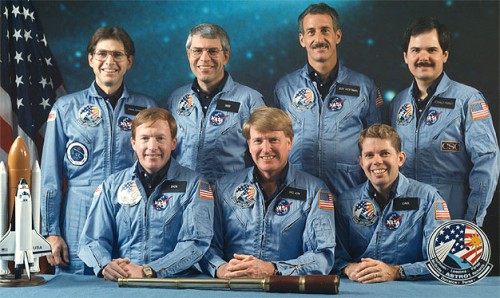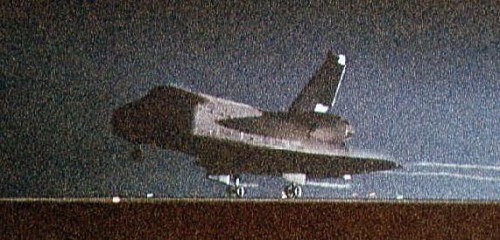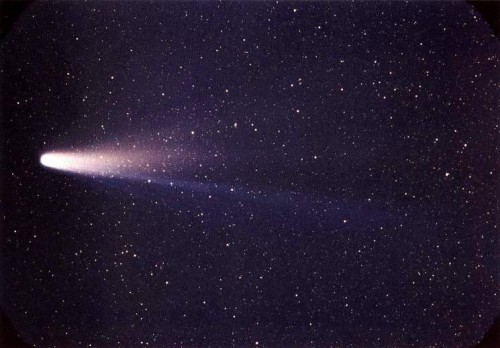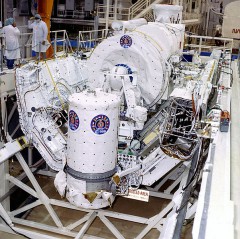
On the morning of Tuesday, 28 January 1986, as seven astronauts prepared to ride Challenger into orbit from Cape Canaveral, Fla., seven other astronauts climbed out of the Shuttle Mission Simulator at NASA’s Johnson Space Center in Houston, Texas, to watch the event on television. The men of Mission 61E knew that their own flight, barely five weeks hence, was time-critical, for it would make ultraviolet observations of Halley’s Comet, which was making its 75-yearly visit to the inner Solar System. Seventy-three seconds after Challenger broke the shackles of Earth and climbed for the heavens, she was catastrophically lost with all hands … and the men of 61E knew that their own mission was gone. Little could they have known that if Challenger had survived that day, there was an enormous likelihood that disaster may have befallen them instead. …
It has long been the subject of both idle and educated coffee-table gossip to consider what-if scenarios in the space program, and all astronauts were acutely aware that, no matter the precautions and safeguards, tragedy lurked behind ever corner. The shuttle was such a complex machine—with more than 800 “Criticality One” items, capable of causing Loss of Vehicle and Crew in the event of a failure—that it would be foolhardy to believe otherwise. Yet it was more than a mere check of the odds which seemed to load the dice against 61E. Years later, Mission Specialist Bob Parker told the NASA oral historian that the frigid weather conditions which contributed to Challenger’s doom were even colder on the night of 5/6 March 1986, when he and his crewmates should have launched aboard Columbia.
And if NASA’s shuttle manifest was to be believed, the night of 5/6 March was the date on which the new mission would set sail. It would have been a difficult target to meet, for Columbia had only returned from her previous flight, Mission 61C, in mid-January, leaving an astonishing six weeks to prepare the vehicle for space. (This is remarkable, when one considers that even in its heyday in the mid-1990s, flying a combined total of seven times each year, the individual orbiters required at least four months to process between missions.) Yet for Parker and his crewmates, getting 61E into space on time was not simply required, but virtually set in stone.
“We were preparing to fly in 40 days to observe Halley’s Comet,” remembered Parker. “Obviously we didn’t fly 40 days later!” Yet the bullish attitude of NASA management in the weeks and months leading up to the Challenger tragedy had different priorities … and those were governed almost exclusively by the need to meet launch schedules. The return of Halley’s Comet to the inner Solar System in late 1985 and early 1986 had already provoked a flurry of missions—the International Cometary Explorer (ICE), the European Giotto, the Soviet Vegas, and the Japanese Suisei and Sakigake—to explore the fabled celestial wanderer, and the shuttle was expected to carry cameras and telescopes on three separate missions to observe it.

Of these, 61E was the most important, for Columbia would carry a battery of ultraviolet telescopes, known as “ASTRO-1,” to observe the comet’s progress. In order to complete these observations at the most optimum time, Columbia had to launch early in March 1986. The criticality of this launch date had already been picked up by the press, and Flight International reported as early as December 1985 that the mission “must be launched by 10 March to achieve maximum science return,” warning that “a slip to 20 March would result in the flight’s cancellation.” By the time of the Challenger accident, 61E was scheduled to begin at 5:45 a.m. EST on the 6th. In the years that followed, Bob Parker would prove vocal in his astonishment at such definitive, immovable targets. “It’s amazing,” he said, “when you look back at that, and the rate at which we thought we had to keep pumping this stuff out.” Parker had an expression: The Sun kept rising and setting. Schedule pressure meant nothing in the face of crew safety.
Had Challenger not been lost that frigid January morning, Parker is almost certain that his own mission might have fallen victim to the technical and managerial cancers which riddled the shuttle at this time … for conditions in Florida in the early hours of 6 March were even colder, and the effect of cold weather on O-ring seals in the Solid Rocket Boosters was later identified as a key factor in the accident. It is almost certain that NASA would have pressed ahead with the 61E launch and, if Columbia made it to orbit safely, it promised to be one of the most exciting scientific missions to date. Although it will never be known if Columbia could have been ready in time, NASA was still aiming to launch 61E at 5:45 a.m. EST on the 6th, kicking off an ambitious flight, during which the seven-man crew would have worked in two 12-hour shifts to operate ASTRO-1 around the clock. The “red” team comprised Parker, Pilot Dick Richards, and Payload Specialist Sam Durrance, with Mission Specialists Dave Leestma and Jeff Hoffman and Payload Specialist Ron Parise on the “blue” team. Commander Jon McBride, meanwhile, would have anchored his schedule across both shifts.
When the Crew Activity Plan for 61E was published by NASA in November 1985, it was expected that the flight would run to almost nine days, making it the second-longest shuttle mission in history at that time. Landing was scheduled for 3:47 a.m. EST, 15 March. As the lead Mission Specialist, Jeff Hoffman had spent almost four years working on ASTRO-1. He had been approached by George Abbey, the head of Flight Crew Operations, in 1982 to follow the mission and determine if it was sufficiently complex to warrant a pair of Payload Specialists. Hoffman was vocal in his conviction that it was, but worried that NASA senior managers opposed the idea of astronauts selected and trained outside of the agency’s immediate jurisdiction. “We knew George Abbey didn’t like the idea of Payload Specialists,” Hoffman told the NASA oral historian, years later. “Was writing this report going to be career-limiting?” Abbey’s powerful ability to approve or veto astronaut selections was known to be immense, but Hoffman need not have worried: in June 1984, he and Bob Parker were formally announced as Mission Specialists and were later joined by Durrance and Parise, followed, in January 1985, by McBride, Richards, and Leestma.

The three ASTRO-1 instruments were the Hopkins Ultraviolet Telescope (HUT), the Ultraviolet Imaging Telescope (UIT), and the Wisconsin Ultraviolet Photopolarimeter Experiment (WUPPE), and all were attached to a device known as the Instrument Pointing System (IPS) in the shuttle’s payload bay, which would direct them toward their celestial targets. Organizational, technological, and schedule difficulties had mired the IPS development effort for more than a decade before it flew its first mission in July 1985, with generally favorable results. However, before Challenger, one senior ASTRO-1 manager told Flight International that if the IPS failed, “the whole mission is down the drain.” It was not an idle statement, for ASTRO-1 was actually the first of three missions to be flown at six-monthly intervals in 1986-87. And the jewel in the crown, dated and fated to behold Halley’s Comet in all its glory, was Mission 61E itself.
In the aftermath of Challenger, the entire crew was stood down, indefinitely. For Jeff Hoffman, the decision to stick around and wait for ASTRO-1 was an easy one to make, but other astronauts felt otherwise. At length, in November 1988, a new ASTRO-1 crew was formed from the remnants of 61E: Hoffman, Parker, Durrance, and Parise would fly aboard the redesignated STS-35, together with McBride in command, and two other astronauts, Guy Gardner as pilot and a third mission specialist, Mike Lounge. A few months later, in May 1989, McBride abruptly resigned his post to return to his native West Virginia, and NASA replaced him with veteran astronaut Vance Brand.

In his NASA oral history, McBride rationalised his thinking. Shortly after his assignment to STS-35, rumors arose that ASTRO-1 was destined for cancellation. “My wife and I had bought a home in West Virginia, in the beautiful Greenbrier Valley,” he explained, “and I was commuting.” McBride saw his family every two or three weeks, until one morning something changed. “I looked out the back window and there were deer and pheasants and squirrels and rabbits,” he said, “and seeing the Greenbrier River and the snow-capped peaks … I [had] two choices. I can hang it up now and come back here to West Virginia … or I can go down to Houston and take a chance of training for two more years and never going anywhere.” By his own admission, the choice was tough, but at length McBride called Don Puddy, then head of Flight Crew Operations, with his decision. “I might be the only person in history who was assigned to a mission that pulled out of it,” he admitted. As circumstances transpired, ASTRO-1 did fly, but years later McBride felt that he made the right decision. In West Virginia, he established a venture capital company, bringing industry and jobs to the area, which he felt enabled him to make a positive impact and open up business opportunities.
In a sense, McBride’s fears for ASTRO-1 partially came true. Although the mission did fly, it also waited nearly two years, lifting off on 2 December 1990 … and that came after seven months of technical delays and maddening mechanical problems which grounded two-thirds of the shuttle fleet. As tomorrow’s article will reveal, getting ASTRO-1 ready to fly in the post-Challenger era was equally as difficult, if not more so, than it had been in the days leading up to the tragedy.
The second part of this article will appear tomorrow.




That fixation on schedule is one thing that doomed the Challenger, the Columbia, and eventually the entire Shuttle program. Sure Halley’s Comet was a good target but it is NOT the only comet! NASA sure blew it by putting an artificial schedule far ahead of “flying and accomplishing something”.
And the crew members could speculate about what the weather would have been like on various possible days but it is a waste of time.